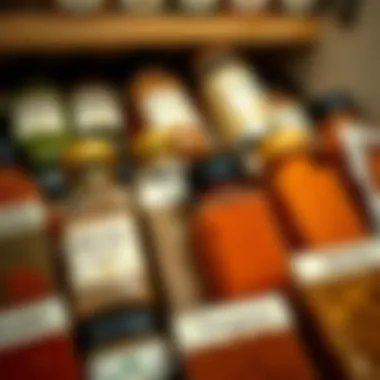Mastering Your Narrow Spice Cabinet for Culinary Success


Intro
A narrow spice cabinet can quite easily transform your culinary experience from mundane to extraordinary. Many folks often overlook the potential of these slender spaces, treating them as simple storage units. However, this guide reveals just how pivotal effective organization and thoughtful spice selection can be. By understanding the nuances of managing a tight space and the importance of the right spices, anyone can elevate their home cooking game.
Spices are not just flavor enhancers; they are the very heartbeat of a dish. Consider this: each spice brings its own personality to the table, from the fiery kick of cayenne pepper to the earthy depth of cumin. But, when your pantry is a jumble, it can feel like finding a needle in a haystack. Hence, implementing a few expert strategies will not only streamline your spice cabinet but also enrich your cooking endeavors and provide you the efficiency needed in the hustle and bustle of home cooking.
In this guide, we will traverse different strategies for organizing spices, selecting the right ones for your specific culinary needs, and maintaining their freshness. As we dig deeper, we’ll also touch on furniture design trends specific to narrow cabinets, and a buying guide that will assist you in maximizing your investment. With each section, expect to uncover ways to hone in on not just what to store in your cabinet, but how to best utilize what you have, ensuring that every single jar works as hard as you do.
Prepare to unleash the full potential of your narrow spice cabinet and, in doing so, take your culinary skills to new heights.
Foreword to Narrow Spice Cabinets
In the world of home cooking, narrow spice cabinets often stand as unsung heroes. These compact storage solutions may seem insignificant at first glance, but they play a crucial role in keeping a kitchen organized and efficient. By understanding how to optimize this small yet important space, homeowners, designers, and DIY enthusiasts can make a significant impact on culinary experiences.
Defining the Narrow Spice Cabinet
A narrow spice cabinet typically refers to a slim, vertical storage unit designed specifically for housing various spices and seasonings. The dimensions can vary widely, but the focus is on utilizing height over width to fit snugly between kitchen elements or even doors. It’s not just about squeezing in as many jars as possible; it’s about creating a system that enhances accessibility and promotes ease of use.
Choosing the right narrow spice cabinet means considering factors such as materials, color schemes, and design aesthetics. Many opt for wooden shelving that exudes warmth, while others may prefer sleek metal options for a contemporary look. Whatever the choice, the cabinet should reflect the overall kitchen style while serving its primary purpose effectively.
The Role of Spices in Cooking
Spices, in many ways, are the unsung champions of flavor in our dishes. They have the power to transform ordinary meals into something extraordinary. Just imagine a dash of cumin elevating a bean soup or a sprinkle of paprika adding warmth to roasted vegetables. They're not just knick-knacks sitting on a shelf; spices are integral to culinary artistry.
Moreover, spices offer a gateway to cultural exploration. Different cuisines employ specific spices that tell stories of tradition and history. For instance, saffron is synonymous with Mediterranean cooking, while cardamom features prominently in Indian dishes. Embracing a variety of spices allows home cooks to venture into a world filled with diverse flavors and aromas.
However, the benefits of having an organized spice cabinet extend beyond aesthetics and mere accessibility. An efficient system can save time, reduce food waste, and even enhance cooking enjoyment. When spices are well-organized, it’s easier to find what you need without rummaging through a chaotic collection. Additionally, a well-maintained spice cabinet ensures that the freshness of spices is preserved, leading to better tasting dishes.
"Incorporating a narrow spice cabinet into your kitchen not only optimizes space, but it also enhances your ability to unleash your culinary creativity."
In summary, narrow spice cabinets serve a dual purpose. They are practical organizational tools and champions of culinary variety. Understanding their role and effectively utilizing them can contribute significantly to a cook’s success and satisfaction in the kitchen.
Evaluating Your Spice Collection
When it comes to a narrow spice cabinet, knowing what you have is half the battle. Evaluating your spice collection is fundamental—it sets the stage for how effectively you can manage and utilize that space. A well-thought-out collection not only aids in culinary creativity but also prevents the waste of valuable ingredients and funds.
Identifying Essential Spices
Before diving into the nitty-gritty of organizing, assess what spices you really need. Think about the types of dishes you prepare most often. For instance, if you find yourself whipping up Italian meals regularly, basil, oregano, and garlic powder should hold prime spots.
To identify your essentials:
- Reflect on Your Cooking Style: If you're a fan of Asian cuisine, make sure you have ginger, turmeric, and star anise at your fingertips. On the other hand, a barbecue enthusiast might prioritize smoked paprika and cumin.
- Consider Versatility: Spices like cumin and coriander work their magic in various dishes, making them worthy of that narrow shelf space.
- Limit Unused Options: This is not the time to hoard spices just because they looked good on a store shelf. Ditch the ones you've used once or twice unless you have plans to experiment further.
By narrowing down to essential spices, you'll not only free up space but also streamline your cooking process. Remember, less can often be more in a cramped environment.
Assessing Shelf Life
Once you've zeroed in on your essential items, it’s crucial to check their shelf life. Just because a spice hasn’t been opened doesn’t mean it will last forever.
- Spices and Their Longevity: Whole spices generally last longer than ground ones. For example, an unopened jar of cumin seeds can last for up to five years, while ground cumin may only stick around for three.
- Visual Inspection: Look for color changes, clumps, or odd smells. Spices should be vibrant; if they have faded into a dusty hue, it’s likely time to say goodbye.
- Rotation System: To keep track of which spices are nearing their expiration, create a rotation system. This might involve placing newly acquired spices in the back of the cabinet while pulling older ones to the front.


"A pinch of prevention is worth a pound of cure." By regularly evaluating your spices, you not only maintain their flavor but also keep clutter at bay.
In addition to checking for freshness and expected shelf life, consider the importance of using spices within their optimum timeline. Be conscious of buying in bulk if you know you won’t use it all, as that can lead to unintentional waste.
Organizational Strategies for Narrow Spaces
When it comes to narrow spice cabinets, how you arrange and manage your space can be a game changer. The importance of organizational strategies can’t be understated, especially for those navigating tight kitchens. Implementing the right systems can open up your cabinet, ensuring that you don’t just store spices, but rather, you access them with ease.
Optimal Layout and Design
The very first step toward creating an organized spice cabinet is the layout. Think of your cabinet as a jigsaw puzzle. Every piece has its place, and understanding how those pieces fit together can make the difference. Start with categorizing your spices into groups such as:
- Herbs (like oregano and thyme)
- Ground spices (think paprika and cumin)
- Whole spices (like cloves and peppercorns)
By clustering like items together, you not only make your cabinet look neater but also save time finding your go-to ingredients. Also, positioning the most frequently used spices at eye level makes perfect sense; trying to reach for that rarely used allspice tucked in the back can be a drag. Imagine the frustration when you're in the middle of making a robust curry and suddenly realize you’ve gotta dig for that elusive spice.
Using Vertical Space Efficiently
In a narrow cabinet, vertical space is often the unsung hero. Consider investing in tiered shelves or risers. This allows you to place spices on different levels, maximizing every inch. When you can see everything at a glance, like a farmer's market spread laid out beautifully, reaching for what you need becomes a breeze.
Utilizing magnetic spice jars on the side of your cabinet door or nearby wall can also free up shelf space while adding a sleek look. Picture those tiny jars, labeled and showing their colorful contents, all within arm's reach. It adds a touch of flair to functionality.
Segmentation and Labeling Techniques
Finally, let’s talk about segmentation and labeling. This is where organization really shines. Clear, consistent labeling is essential—without it, all your hard work can easily fall apart.
Using a label maker or even handwritten labels can work wonders. Ensure that the label is large enough to read easily, yet small enough not to overwhelm the jars.
- Clear containers not only keep moisture out but also allow you to spot the spice at a quick glance.
- Color coding different types of spices can serve as a visual cue; imagine seeing a pop of green for your herbs and a vibrant red for your hot spices.
"An organized spice cabinet not only saves time but creates a culinary environment that inspires creativity in the kitchen."
By applying these strategies—thoughtful layout, efficient use of vertical space, and precise labeling—you’ll ensure your narrow spice cabinet is more than just a place to stash jars. It can become a well-oiled machine that enhances your cooking experiences and keeps you coming back for more delicious experiments in the kitchen.
Storage Solutions for Narrow Spice Cabinets
Navigating the narrow confines of spice cabinets can be a bit like trying to squeeze into your favorite pair of jeans after the holidays—challenging and often frustrating. However, implementing the right storage solutions can transform what initially seems like a cramped space into a showcase for your culinary creativity. The goal is not just to stow away jars but to create an accessible and visually pleasing arrangement that inspires you every time you reach for that sprinkle of cumin or dash of paprika.
When you have limited space, efficiency is key. A well-organized spice cabinet can streamline your cooking process and ensure that each ingredient is easy to find when you need it. In this section, we will delve into some innovative storage solutions that maximize utility without sacrificing aesthetics.
Pull-Out Drawers for Accessibility
Pull-out drawers are like having a secret weapon in your kitchen arsenal. They provide immediate access to your spices, reducing the hassle of reaching into the back of a cabinet where jars may languish in obscurity. Imagine being able to simply slide open a drawer and see all your spices lined up, ready to use.
- Convenient Access: With pull-out drawers, every jar is at your fingertips, cutting down the time spent searching for that elusive spice—no more digging through a pile of jars or missing that jar of coriander hiding at the back.
- Customization: You can customize the depth and layout of the drawers based on the size of your jars, allowing you to use every inch of space wisely. For example, shallow drawers could hold smaller spice containers, while deeper drawers could accommodate more oversized items.
- Easy Maintenance: Since they are fully visible, it becomes easier to maintain organization. You can quickly note when supplies are running low, making reordering a breeze.
Magnetic Spice Jar Innovations
Adopting magnetic spice jars is something akin to having a Pinterest board come to life. They free up precious cabinet space by utilizing the walls of your cabinet or even your refrigerator. Magnetic jars offer an imaginative yet practical storage solution that combines fun with functionality.
- Space-Saving: By sticking to a magnetic strip, these jars not only look trendy but also keep everything in a tidy row—an eye-catching display that can turn your spices into a decorative feature of your kitchen.
- Labels and Visibility: Most magnetic jars come with labels, allowing for instant recognition. With jars clearly marked, you won’t have to fumble around reading tiny print; it’s all there at a glance.
- Versatile Usage: Whether you choose to mount them on the side of your refrigerator, on a metal rack, or inside a cabinet, this solution adapts easily to various kitchen styles and spaces, thus giving you options.


Tiered Racks and Shelves
Tiered racks and shelves echo a simple truth: layers add dimension. These organizational solutions allow you to showcase your spices effectively while maximizing vertical space—an often neglected area in narrow cabinets.
- Maximize Verticality: Utilizing tiered racks means you get to take advantage of the height of your cabinet, making it possible to stack spices without losing track of them. This way, you won’t always be bending down or reaching awkwardly to grab a spice from a lower shelf.
- Easy Mixing and Matching: These racks offer the flexibility to mix and match various sizes of spice jars. For instance, smaller jars can fill in gaps next to slightly larger ones, resulting in a neat, orderly appearance.
- Enhanced Visibility: When spices are displayed on different levels, you get a clear view of your collection. No more expired spices gathering dust because you forgot what you had!
"An organized spice cabinet doesn’t just make cooking easier; it inspires creativity and adventure in the kitchen."
In essence, choosing the appropriate storage solutions is a pivotal step in optimizing your narrow spice cabinet. Whether you prefer pull-out drawers, magnetic jars, or tiered racks, each option has unique benefits that can ultimately enhance not just organization but also your cooking experience. Prioritizing convenience and accessibility will not only enhance the efficiency of your cooking routine but also add a touch of thoughtfulness to your space.
Best Practices for Spice Maintenance
Maintaining your spice cabinet isn’t just about having all those jars neatly tucked away. Proper spice maintenance can play a crucial role in enhancing your culinary creations. Spices, if cared for correctly, can turn even the most mundane dishes into culinary delights. Conversely, neglected spices can quickly lose potency, rendering them nearly useless. In this section, we will explore the essential practices that can help ensure your spices stay fresh, flavorful, and ready to use.
Proper Storage Conditions
Spices require particular storage conditions to preserve their natural flavors and aromas. First and foremost, keep spices in a cool, dark place, away from heat sources like the stove or direct sunlight. Excessive heat and light can degrade the quality of your spices faster than you might think.
Consider storing spices in tightly sealed containers. Glass jars are a popular choice because they minimize air exposure and won’t leach chemicals into your spices. However, ensure these jars are opaque or stored in a way that keeps them out of the direct light. Labeling is also key; a simple label with the spice name and date of purchase can help track freshness and usage.
"Spices lose their flavor gradually over time, and many can go stale within six months to a year. Proper storage can dramatically extend their shelf life."
Regular Inventory Checks
Imagine wanting to whip up a flavorful curry only to find out that your cumin is a no-show. This situation can be avoided with regular inventory checks. At least every few months, take a few minutes to review your spice collection. Check for any spices that seem to have lost their aroma or color, as these are indicators that they might no longer be at their best.
While checking your spices, also use this opportunity to reorganize them. Grouping similar spices together or arranging them by frequency of use can save valuable time during your cooking spree. If you come across duplicates or jars that have lingered unused for too long, consider donating those extra jars to friends or a local food bank. It's an excellent way to declutter while ensuring good spices don’t go to waste.
Effective Rotation Techniques
Implementing effective rotation techniques ensures that older spices are used before newer purchases. A simple method to achieve this is to place new purchases behind older items, making a sort of 'first in, first out' (FIFO) system. When restocking your spices, simply add the newest jars to the back of the cabinet or shelf.
Additionally, consider using clear containers for easy visibility. This way, you can quickly keep track of what needs using soonest. Establishing a routine can help too—incorporate a quick spice check during your regular grocery trips or meal prep days to remind yourself to use those oldest jars first.
By following these best practices, you can not only maintain your spice collection but also elevate the flavors of your dishes. Ensuring your spices are well-kept allows you to get the most out of your narrow spice cabinet and, in turn, your culinary endeavors.
For more information on spice storage techniques and best practices, check out this guide from Wikipedia or the resources at Britannica.
Customizing Your Spice Cabinet
Customizing your spice cabinet is more than just a process; it’s about merging functionality with personal style. With limited space to work with, every inch matters. The essence of customizing lies in tailoring the cabinet to fit not only your cooking habits but also your aesthetic preferences. This ensures that your spices are not just stored but are transformed into a visually pleasing component of your kitchen. When exploring the importance of customization, we delve into two main areas: selecting the right containers and introducing aromatic plants.
Personalizing with Spice Jars
The choice of spice jars can significantly influence both practicality and appeal. Mason jars, glass containers, or even hermetically sealed tins not only help keep your spices fresh but also allow you to showcase your unique flair. When selecting jars, consider the size based on the spice types and usage frequency. Big jars may suit bulk spices, while smaller jars may work better for rare or specialty spices.
Using clear containers can provide a visual cue for identification. When you glance at a uniform row of jars, it’s easy to identify what’s what, preventing the frustration of searching through clutter. Custom labels can enhance this further. Think about designs that resonate with your personal style—whether rustic, modern, or playful.
- Benefits of custom spice jars:
- Visual appeal, making the spice cabinet a part of your kitchen decor.
- Easier access and organization with clear labeling.
- Reduced likelihood of flavor loss, given proper sealing.


"Personalization in your spice cabinet goes beyond mere aesthetics and truly enhances your cooking experience."
Consider experimenting with various jar shapes—squat jars can fit neatly into tight spaces, while taller jars work beautifully in cabinets with height. In the end, the customization of spice jars leads to not only a more organized cabinet but also a pleasant cooking atmosphere that reflects your personality.
Incorporating Aromatic Plants
Adding aromatic plants to your spice cabinet can elevate the cooking experience significantly. It provides a fresh element, not only in sight but also in scent. Basil, thyme, and rosemary are just a few options you can cultivate right in your kitchen.
Aromatic plants bring several advantages:
- Freshness: Nothing beats the flavor of freshly snipped herbs.
- Sustainability: Growing your herbs reduces the need for pre-packaged options, contributing positively to the environment.
- Air Quality: Plants naturally purify the air, enhancing the overall kitchen environment.
When deciding how to incorporate plants, think about accessibility and sunlight. A small shelf or a simple windowsill can be an ideal spot for your herbs. Opt for pots that complement your jars; this rolling combination will unify the look while providing a functional element for your cooking needs. Alternatively, consider using vertical garden systems specifically designed for herbs, maximizing your limited space.
Strategically customizing your spice cabinet with personalized jars and aromatic plants can transform a basic storage space into a dynamic cooking hub, making it more than just a place to keep spices. It becomes a sanctuary of flavor and a reflection of your culinary style.
Innovations in Spice Cabinet Design
In today’s fast-paced culinary world, the way we organize our spice cabinets can significantly enhance our cooking experience. Innovations in spice cabinet design are not just about aesthetics; they directly affect functionality and ease of use. Clever design choices can transform a cluttered cabinet into an efficient space that promotes creativity in the kitchen.
Smart Technology Integration
Bringing smart technology into spice cabinet design represents a leap forward for culinary enthusiasts. Imagine a spice cabinet equipped with sensors that keep track of your spice inventory, notifying you when supplies run low. Or consider a system that suggests recipes based on the spices available in your cabinet. Integrating smart technology not only reduces the time spent searching for that elusive jar of cumin but also encourages a more spontaneous cooking experience.
These systems often utilize mobile apps linked to your kitchen’s Wi-Fi, enabling you to check your spice inventory while you’re out shopping. For example, brands like Tovala are pioneering kitchen tech that includes smart food ovens capable of scanning and identifying spices. It’s an exciting time for tech lovers who are also cooking aficionados, as innovation meets the comforting art of food preparation.
Eco-Friendly Materials
With a heightened awareness of environmental issues, many homeowners and designers are turning to eco-friendly materials when optimizing their spice cabinets. Bamboo, reclaimed wood, and recycled metals are gaining popularity for their sustainability and durability. Not only do these materials add a natural aesthetic to your kitchen, but they also contribute positively to the environment.
Using eco-friendly options often involves less chemical processing during manufacturing, making them safer for home kitchens. Plus, many of these materials are sturdy enough to endure daily use without compromising on style.
"By choosing eco-friendly materials, you’re not just designing a kitchen; you’re investing in the health of the planet - one spice jar at a time."
As consumers become more environmentally conscious, brands that incorporate green practices into their products may gain a competitive edge. Therefore, selecting cabinets made from sustainable resources does not merely satisfy ethical considerations; it can boost a home's appeal in a marketplace increasingly focused on sustainability.
End: Embracing the Culinary Journey
As we draw the curtain on this exploration of narrow spice cabinets, it’s essential to acknowledge the profound impact that well-organized spices can have on your cooking adventures. This article highlights not just the practicality of managing a compact spice area but also the joy and creativity it can unlock in culinary endeavors. Embracing an organized spice cabinet can transform the mundane task of cooking into an artistic expression, where every pinch of spice speaks volumes about flavor and culture.
A tightly controlled spice collection signifies more than just efficiency; it’s about crafting an inviting atmosphere in your kitchen while also enhancing the flavors of your dishes. Knowing your spices intimately increases your confidence in the kitchen, allowing you to mix and match with ease, much like a painter blends colors on a palette. The systematic organization of your spice cabinet, as emphasized throughout this guide, leads to easier access and promotes culinary experimentation. When you treat your spices with the consideration they deserve, the entire cooking experience shifts.
"A well-stocked spice cabinet is like a treasure chest for the chef, offering endless possibilities for flavor and creativity."
Reflecting on Spice Utilization
Looking back at what we’ve discussed, spice utilization doesn't merely involve having spices; it's about purpose and intention. Utilizing spices wisely can elevate any dish from ordinary to extraordinary. Reflect on the spices you frequently use and those that sit untouched. It’s a common scenario—opening the cabinet and feeling overwhelmed by the choices or, conversely, disappointed by the lack of inspiration from an underutilized assortment.
Aim to strike a balance. Consider seasonal recipes, cultural cuisines, and personal preferences when choosing which spices to keep handy. An inspired collection can reflect your cooking style and lend to signature dishes that others will rave about. Regularly assess your spice inventory and adjust with the seasons, ensuring you have the right tools for your culinary creations.
Importance of Organization in Cooking
Organization is the unsung hero in a well-functioning kitchen. A cluttered spice cabinet can lead to confusion and lost time, which ultimately affects the joy of cooking. When you can find your spices easily, you're more likely to try new recipes, take risks in flavors, and fall back in love with cooking.
Here’s why organization counts:
- Efficient Cooking: Finding what you need, when you need it, can speed up meal prep, allowing you more time to savor the cooking process.
- Culinary Creativity: An organized spice cabinet sparks creativity, enabling you to experiment more freely with flavors.
- Longevity of Spices: Proper organization prevents misplacement, ensuring spices remain fresh and potent longer.
So, as you navigate your culinary journey, remember that the way you manage your narrow spice cabinet greatly influences your cooking experience. Take the lessons from this guide and apply them to turn your small spice collection into a vibrant part of your cooking life. Being meticulous about organization is not just a chore; it’s a commitment to your craft, a nod to the art of cooking, and a passport to various culinary adventures.















